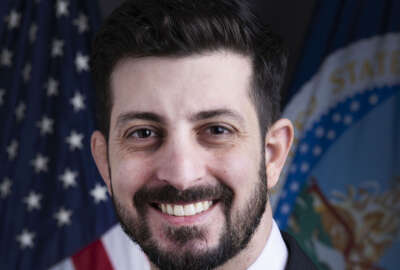A big-department chief human capital officer joins the private sector
After 35 years of federal service, a career Army officer and human capital executive has decided to ply his trade in the private sector.
Best listening experience is on Chrome, Firefox or Safari. Subscribe to Federal Drive’s daily audio interviews on Apple Podcasts or PodcastOne.
After 35 years of federal service, a career Army officer and human capital executive has decided to ply his trade in the private sector. Blair Duncan has done strategic workforce development at both the Commerce and Health and Human Services departments. Now he’s joined the Golden Key Group as executive vice president for federal innovation and transformation. Federal Drive with Tom Temin caught up with him to discuss.
Interview transcript:
Tom Temin: Mr. Duncan, good to have you on.
Blair Duncan: Thanks, Tom, great to be here.
Tom Temin: And just review for us your career, because it’s kind of an unusual one with respect to someone that’s been in and out of government, military and civilian side.
Blair Duncan: Yeah, it is a very strange career. As you mentioned, 21 years in the military, in the Army, I was an aviator, and I did strategic human capital for the Department of Defense and the Army. Following that I retired. And I worked for a contractor for about eight years doing human capital work solely for the federal government, mainly in the civilian side, with some DoD experience in there as well, because of my background. Following that, I started my own company for a little bit. And what I found was, I wasn’t able to really make an impact from being on the outside, I wanted to come back into the federal workspace. So I apply for a federal job just like anybody else would. And I was picked up by NOAA, Department of Commerce to work in their HR organization. I did that for about five years. And then I actually applied for a job within the Department of Health and Human Services, picked up for that position. And I just left the Department of Health and Human Services, where I was the deputy assistant secretary for human resources in the chief human capital officer. So it’s a very varied career. But the majority of it was, except for the actual flying part, I was working with people. How do you optimize people and the processes and getting there?
Tom Temin: By the way, were you vertical lift or horizontal in the helicopter?
Blair Duncan: I flew UH-60s. I had a wonderful career flying, it was a great time.
Tom Temin: And I guess people often overlook the fact that the army, the armed services are in many ways, basically, human training and development organizations as much as technical and combat organizations. A fair way to characterize it?
Blair Duncan: Absolutely. I mean, the first thing you learn in the military in any position is leadership. You’re training, you’re responsible for these people, you’re responsible for the outcome of what happens every day. So it’s ingrained in you. It’s leadership, it’s training, it’s getting the best from the folks that you have, and taking care of them. That’s important.
Tom Temin: And talking about the civilian side of the work you have done in human capital and what they used to call HR. And before that personnel, I guess human capital is more encompassing as to the totality of it. And the government’s talking a lot about modernizing HR and human capital. What does that mean, from your standpoint, and what could be done to modernize how the government approaches people?
Blair Duncan: I separate the two, I separate HR and I separate human capital. The reason why I do that is because there’s always going to be a need to do the transactional type of human resource activities that have been traditionally we can go back to civil service reform of 1978, we’re still doing those human resource requirements that you need to basically track, pay, promote, retire, and hire all these folks, those are the HR activities more transactional, whereas the human capital side is more on the strategic side? How do you do large scale programs, performance management, I would consider as a human capital side. So when you say modernization, what I’m looking at and what I was trying to do within the federal workspace, is how do you modernize that HR, human resources, things we’ve been doing the same way, since 1978. So that’s where there are so many opportunities, with technology, with just the new software that’s coming out. And that’s what my focus is on? How do you take these new platforms, these – RPA, all these things that are flooding the market – but you put them in a space where traditionally been pure transactional work. That’s my focus.
Tom Temin: We’re speaking with Blair Duncan, former chief human capital officer at HHS, now executive vice president of the Golden Key Group. And that brings me to the question of the Office of Personnel Management. And that’s been sort of a political football over the past number of years with administrations and has not had a clear direction in a consistent one with respect to, is it a policy organization? Is it a human capital development organization? Or is it strictly transactional, to make sure the retirement benefits get calculated, and the right rules get in place for the policies others decide? What’s your view on OPM and where it should head?
Blair Duncan: I definitely believe OPM should take the lead on becoming the government’s premier human resources and human capital organization. They need to be the ones that not only set the policy, but they need to be the ones lobbying for new changes the policies, they need to be out front. And how do we do things as a whole in the government, not just as a single entity, for instance, when I was the CHCO, there are a lot of CHCO agencies that we all do it in a different way. There needs to be somebody that at least sets the benchmark for where we can come together, agencies come together, agencies can collaborate together, and they’re much more powerful than they are with just being left alone. And that’s where I think OPM needs to come to the table, bring the CHCO’s together, bring the human resources community together, and be the government voice for HR. One of the things I’ve always been an advocate of, coming from the military, there’s this thing called recruiting command, all the services have them, their whole function is to get people to work for them. Where is the federal government’s central point for recruitment? There isn’t one, there could be one. How do we as a government recruit the generation Z’rs? Well, there’s a whole bunch of agencies out there doing that a whole bunch of different ways. That’s where I think OPM can come and pull the HR community together. And I think you’ll have a much, much more powerful organization and sharing of those best practices. But then overseeing what gets done is also very important.
Tom Temin: And one of your initiatives while in the government was the running of the CHCO collaborative. And what did or does that do, and can that be a vehicle to feed up into OPM? I think the CHCO collaborative or the CHCO Council is under OPM at this point anyway.
Blair Duncan: Yes, the CHCO Council is definitely under OPM. When I departed the federal government, I do know that the CHCO collaborative was still out there. Another CHCO out there has taken over. And really what it was was, and it’s very important, and I’m really glad that we got to stand that up, was it was a free for all to talk, it was a place to come share your ideas, share your pain points, just to have that conversation. And as we went along in the beginning, OPM really wasn’t invited because, OPM they have a bad rap in that, you don’t want them there. You don’t want to let them know what you’re doing, because you might get told not to do it. But over time, we started to bring them in and they were very amenable to – hey, let’s work with OPM. OPM is there to help. They really are. I truly believe that. And I know the leadership that’s in there now is there to help the agencies. So over time, we began to bring them on and say, hey OPM what do you think about this? How can we work with OPM instead of maybe not with OPM?
Tom Temin: And briefly while we have you just tell us in a sentence or two about Golden Key Group?
Blair Duncan: Golden Key Group is a smaller organization. And what drew me into golden key group was their leadership, their leadership is all about trying to make the federal government HR workspace a better place, how do we, as a contractor, go in and help them become more effective and efficient, not in the old fashioned way where you do studies and analysis, but really go in and say, here, I’m going to show you a product that actually will help you and it’s more in the RPA and the technology and the transformative approach. And that’s what this agency wants to do, they want to be at the forefront of technology.
Tom Temin: Alright, and anything can be done to help, as we mentioned earlier, those retirement calculations, which are done apparently by hand and paper and the Victor adding machine?
Blair Duncan: You would be shocked at what gets done via the old paper method within the HR workspace. Actually, I don’t think you would be shocked. You just mentioned one right there.
Tom Temin: All right. Blair Duncan is former Chief Human Capital Officer of HHS, now executive vice president of the Golden Key Group. Thanks so much for joining me.
Blair Duncan: Thanks, Tom. Appreciate it.
Copyright © 2025 Federal News Network. All rights reserved. This website is not intended for users located within the European Economic Area.
Tom Temin is host of the Federal Drive and has been providing insight on federal technology and management issues for more than 30 years.
Follow @tteminWFED






